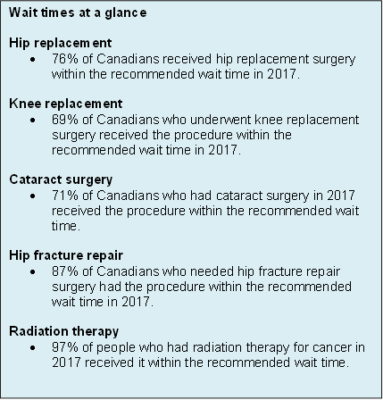By Riley Denver
Let’s face it — no one likes to wait. This is especially true when you or a loved one can’t receive immediate care, whether it’s making an appointment with your family doctor or receiving more urgent life-saving surgery.
As part of an ongoing focus on wait times in Canada, the Canadian Institute for Health Information (CIHI) recently released updated wait time information for selected procedures in its Wait Times web tool.
Most Canadians continue to receive hip fracture repair and radiation therapy within recommended wait times
First, some encouraging news: approximately 9 out of 10 Canadians received their hip fracture repair or radiation therapy within the recommended wait times in 2017.
The benchmark wait time for hip fracture repair in Canada is 48 hours. Eighty-seven percent of Canadians had their procedure within the benchmark time frame in 2017 — the same as in 2015.
In the treatment of cancer, 97 per cent of radiation therapy was administered within 28 days — the Canadian benchmark. That percentage was also consistent with 2015 results.
Wait times grow for joint replacement and cataract surgery, despite more procedures being performed
Patients are waiting longer for joint replacements in Canada than they did even a few years ago.
Last year, about three out of four patients (76%) received a hip replacement within the recommended wait time of 6six months. The percentage was 81 per cent in 2015.
Just less than 70 per cent of patients who had a knee replacement had their procedure within the recommended 6-month time frame in 2017. That was fewer patients than in 2015, when 77 per cent had their procedure within the benchmark.
The story is similar for cataract surgery patients: 71 per cent had the procedure within the recommended wait time of 16 weeks in 2017, compared with 76 per cent in 2015.
These longer waits were observed even though the number of procedures increased. There were seven per cent more hip replacements and six per cent more knee replacements done last year than in 2015. The number of cataract surgeries also increased by three per cent in that time.
Why the wait?
Many factors contribute to longer wait times.
These procedures are frequently associated with older patients. The last census showed that, for the first time, there are more seniors than there are children younger than 14 in Canada. The aging population could play a part in the increased demand for joint replacements and cataract surgeries.
In addition, improvements in surgical practices, procedures and devices also expand the number of people who are eligible for surgery.
More information on wait times
These procedures are only a small part of the wait time story in Canada. Measuring and monitoring wait times is an important step toward improving access to care. CIHI has several resources Canadians can use to understand the larger picture.
CIHI’s Wait Times web tool also includes data on cancer surgery and diagnostic imaging wait times for you to explore.
You can also look at wait times in Canada’s emergency departments in the Quick Stats section of cihi.ca.
See how Canada compares internationally with data from the Organisation for Economic Co-operation and Development.
Timely access to medical treatment is important to all Canadians, and CIHI will continue to report on access to care in Canada.
Riley Denver is a Communications Specialist at The Canadian Institute for Health Information (CIHI).


